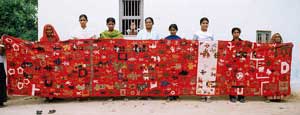| The Katha Collection: An Exploration of Personal Expression | ||




 |
|
The narrative form is not a traditional art in Kutch. Kala Raksha artisans first experimented with personal expression for two exhibitions that were developed following the earthquake of 2001. One project culminated in the “Resurgence” exhibition, which was shown in Manly Australia and later purchased by the Prince of Wales Museum in Mumbai. Kala Raksha artisans expressed interest in further exploration of narrative art, and since 2001, this new form of art has developed as the artists embarked on an extraordinary journey of self expression, and gained confidence and maturity. The narrative pieces are not seen as a substitute for traditional art, but an addition to it, and the pieces hold a place of pride in the hearts and minds of the artists. Each cultural group invented a unique stylistic form, in which each artisan developed a personal style. Once they had a means to express, they found they had a lot to say. Themes vary widely – from ostensibly simple events like a wedding in the family to complex ideas like the settling down of a nomadic people. Similarly, scale varies from relatively modest sizes to large pieces that may need simultaneous work by a team of artists. Much like a painter or a sculptor, each artist’s involvement with her work is complete and each piece is characterized by the artist’s own inimitable worldview – in turns dramatic, touching and humorous. Most significant, the new focus on the art of craft automatically generated strong feelings of engagement of artisans in their work, and the artists immediately knew that this body of work was valued in a different way. To date, Kala Raksha has held four narrative exhibitions under the title of The Katha Collection: Fabricated Tales from Kala Raksha. The first, was held in Mumbai at The Artists Center in spring of 2006. In March 2007, a follow up, “Our Universe” was held at Chemould Gallery, Mumbai. In April 2008, the third in the series: “The Ripple Effect: Kala Raksha Artisans Reflect on Water,” was held at The Artists Center, Mumbai and later at UNDP and IIC, New Delhi. The latest Katha Collection, “Kutch is the Center of the World,” will be held at the Artists Center in January 2010. Artisan Megiben Meriya created a piece to illustrate one of the United Nations 8 Millennia Goals for an exhibition at UNDP Delhi in 2007. In September 2008, Artisan Raniben Ratilal Bhanani taught two workshops on narrative appliqué in Australia. Kala Raksha’s narrative work has been covered in an article in International Gallerie, “Needle and Narrative: Stories on Cloth,” Vol. 9, No. 1, 2006. In addition, Kala Raksha produced 15,000 narrative works based on six master pieces as a Corporate Gift for Bestseller, a Denmark based company. This was accompanied by brochures on the narrative tradition in India, and on the Kala Raksha project, and a short documentary film on the Kala Raksha narrative project. The collection received the 2008 UNESCO Seal of Excellence award. In 2009, acclaimed film maker Nina Sabnani created an animated documentary, Tanko Bole Chhe: The Stitches Speak, using the work and voices of the artisans themselves. The film has already won four awards: Best Short film at the Stuttgart Film Festival Bollywood and Beyond, Best Creativity at the Int.’l Short Film Festival of India, and Jury's special prize for a short animation, and award for short animation for Social welfare at the FICCI BAF Festival. The film is available as “The Stitches Speak” from Documentary Educational Resources and is available in India only through Kala Raksha. |
||